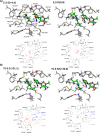Computational Study of Mechanism and Enantioselectivity of Imine Reductase from Amycolatopsis orientalis
- PMID: 34825518
- PMCID: PMC8734122
- DOI: 10.1002/open.202100250
Computational Study of Mechanism and Enantioselectivity of Imine Reductase from Amycolatopsis orientalis
Abstract
Imine reductases (IREDs) are NADPH-dependent enzymes (NADPH=nicotinamide adenine dinucleotide phosphate) that catalyze the reduction of imines to amines. They exhibit high enantioselectivity for a broad range of substrates, making them of interest for biocatalytic applications. In this work, we have employed density functional theory (DFT) calculations to elucidate the reaction mechanism and the origins of enantioselectivity of IRED from Amycolatopsis orientalis. Two substrates are considered, namely 1-methyl-3,4-dihydroisoquinoline and 2-propyl-piperideine. A model of the active site is built on the basis of the available crystal structure. For both substrates, different binding modes are first evaluated, followed by calculation of the hydride transfer transition states from each complex. We have also investigated the effect of mutations of certain important active site residues (Tyr179Ala and Asn241Ala) on the enantioselectivity. The calculated energies are consistent with the experimental observations and the analysis of transition states geometries provides insights into the origins of enantioselectivity of this enzyme.
Keywords: biocatalysis; enantioselectivity; imine reductase; reaction mechanism; transition state.
© 2021 The Authors. Published by Wiley-VCH GmbH.
Conflict of interest statement
The authors declare no conflict of interest.
Figures









Similar articles
-
Identification of imine reductase-specific sequence motifs.Proteins. 2016 May;84(5):600-10. doi: 10.1002/prot.25008. Epub 2016 Mar 6. Proteins. 2016. PMID: 26857686
-
Structural Characterization of an S-enantioselective Imine Reductase from Mycobacterium Smegmatis.Biomolecules. 2020 Jul 31;10(8):1130. doi: 10.3390/biom10081130. Biomolecules. 2020. PMID: 32751900 Free PMC article.
-
Extended Catalytic Scope of a Well-Known Enzyme: Asymmetric Reduction of Iminium Substrates by Glucose Dehydrogenase.Chembiochem. 2017 Sep 5;18(17):1703-1706. doi: 10.1002/cbic.201700261. Epub 2017 Jul 19. Chembiochem. 2017. PMID: 28722796
-
Imine reductases (IREDs).Curr Opin Chem Biol. 2017 Apr;37:19-25. doi: 10.1016/j.cbpa.2016.11.022. Epub 2016 Dec 27. Curr Opin Chem Biol. 2017. PMID: 28038349 Review.
-
Biocatalytic reductive aminations with NAD(P)H-dependent enzymes: enzyme discovery, engineering and synthetic applications.Chem Soc Rev. 2024 Jan 2;53(1):227-262. doi: 10.1039/d3cs00391d. Chem Soc Rev. 2024. PMID: 38059509 Review.
Cited by
-
A Quantum Mechanical Approach to The Mechanism of Asymmetric Synthesis of Chiral Amine by Imine Reductase from Stackebrandtia Nassauensis.Chempluschem. 2025 Jan;90(1):e202400606. doi: 10.1002/cplu.202400606. Epub 2024 Nov 15. Chempluschem. 2025. PMID: 39434680 Free PMC article.
-
Computational design of an imine reductase: mechanism-guided stereoselectivity reversion and interface stabilization.Chem Sci. 2023 Dec 15;15(4):1431-1440. doi: 10.1039/d3sc04636b. eCollection 2024 Jan 24. Chem Sci. 2023. PMID: 38274081 Free PMC article.
-
The Quantum Chemical Cluster Approach in Biocatalysis.Acc Chem Res. 2023 Apr 18;56(8):938-947. doi: 10.1021/acs.accounts.2c00795. Epub 2023 Mar 28. Acc Chem Res. 2023. PMID: 36976880 Free PMC article. Review.
-
Deciphering the Unconventional Reduction of C=N Bonds by Old Yellow Enzymes Using QM/MM.ACS Catal. 2024 Jan 10;14(3):1257-1266. doi: 10.1021/acscatal.3c04362. eCollection 2024 Feb 2. ACS Catal. 2024. PMID: 38327643 Free PMC article.
-
Physics-based modeling in the new era of enzyme engineering.Nat Comput Sci. 2025 Apr;5(4):279-291. doi: 10.1038/s43588-025-00788-8. Epub 2025 Apr 24. Nat Comput Sci. 2025. PMID: 40275092 Free PMC article. Review.
References
-
- Schrittwieser J. H., Velikogne S., Kroutil W., Adv. Synth. Catal. 2015, 357, 1655.
-
- Ghislieri D., Turner N. J., Top. Catal. 2014, 57, 284.
-
- None
-
- Savile C. K., Janey J. M., Mundorff E. C., Moore J. C., Tam S., Jarvis W. R., Colbeck J. C., Krebber A., Fleitz F. J., Brands J., Devine P. N., Huisman G. W., Hughes G. J., Science 2010, 329, 305; - PubMed
-
- Busto E., Gotor-Fernandez V., Gotor V., Chem. Rev. 2011, 111, 3998; - PubMed
Publication types
MeSH terms
Substances
Supplementary concepts
Grants and funding
LinkOut - more resources
Full Text Sources

